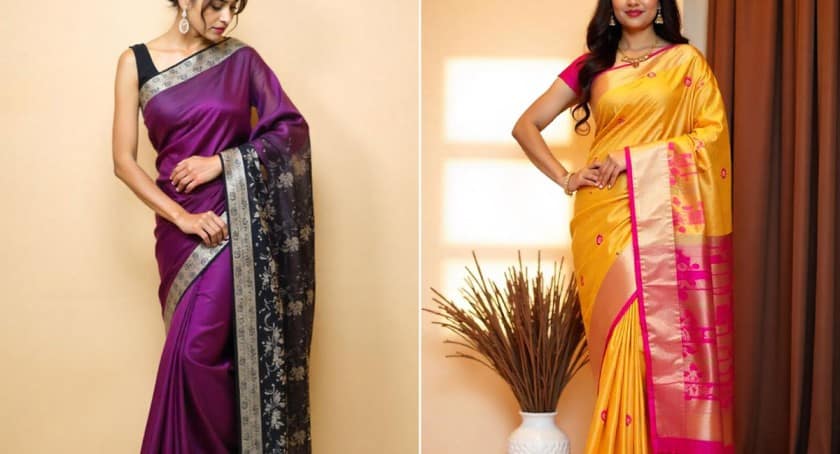Difference between Sambalpuri vs. Bomkai Sarees
Sarees are integral to India’s rich cultural heritage, with each region’s distinct style and weaving tradition. Among the beautiful handloom sarees from Odisha, Sambalpuri and Bomkai stand out for their complex artistry, vibrant colors, and deep-rooted traditions. While both sarees originate from the same state, they have unique characteristics that set them apart. In this blog, we shall examine the distinctions between Sambalpuri vs Bomkai sarees, assisting you in appreciating their beauty and individuality.
Tradition-Based: The Legacy of These Iconic Sarees
Sambalpuri Sarees:
Sambalpuri sarees originate from the Sambalpur region of Odisha. They are well known for their Bandha or Ikat tie-and-dye method. The uniqueness of these sarees lies in the designs dyed onto the yarn before weaving, making them an extraordinary display of precision and craftsmanship.
Bomkai Sarees:
Bomkai sarees, also called Sonepuri sarees, originate from Bomkai, a village in the Ganjam district of Odisha. These sarees are known for their extra weft weaving technique, which creates complex fabric thread work. They are a perfect mix of simplicity and grandeur, making them ideal for everyday wear and festive occasions.
Art in Every Thread: Weaving Techniques that Dazzle
Sambalpuri Sarees:
The distinguishing feature of Sambalpuri sarees is the Ikat weaving process, which involves resist-dyeing the warp and weft threads before weaving. This process results in vibrant and symmetrical patterns on both fabric sides. Dyeing and drying the threads multiple times ensures that the colors remain bright and do not fade quickly. The precision required for this technique makes each Sambalpuri saree a masterpiece.
Bomkai Sarees:
In Bomkai sarees, weavers use the extra weft weaving technique, interweaving additional threads to create complex patterns on the pallu and borders. The designs are woven directly onto the fabric, giving it a slightly raised texture. This technique allows artisans to incorporate complex motifs inspired by tribal art, mythology, and nature. Unlike Sambalpuri sarees, Bomkai sarees have a more elaborate and textured appearance.
Motifs that Speak: The Stories Woven Within Sambalpuri vs. Bomkai Sarees
Sambalpuri Sarees:
Sambalpuri sarees are renowned for their geometric patterns and traditional motifs. Some of the most common designs include:
- Shankha (Conch Shell)
- Chakra (Wheel)
- Phula (Floral Patterns)
- Animals and Birds like elephants and peacocks
Bomkai Sarees:
Bomkai sarees, on the other hand, are known for their intricate mythological, tribal, and nature-inspired motifs. These sarees often feature:
- Fish, tortoise, and lotus motifs (symbolizing prosperity and good luck)
- Temple designs and tribal art
- Pata (rectangular box) patterns on the pallu
Silk or Cotton? The Fabric that Defines the Drape
Sambalpuri Sarees:
Weavers craft Sambalpuri sarees in cotton and silk. The cotton variants are lightweight and breathable, perfect for daily wear, while the silk versions have a lustrous sheen, ideal for festive occasions. The fabric is smooth and soft, with a fine, even texture.
Bomkai Sarees:
Weavers primarily weave Bomkai sarees in silk and cotton, but the silk versions are more popular due to their royal appearance. The extra weft weaving technique adds a textured feel to the fabric, making it slightly heavier than Sambalpuri sarees. People particularly favor silk Bomkai sarees for grand celebrations and temple rituals.
The Color Palette: Bold vs. Opulent Hues
Sambalpuri Sarees:
Sambalpuri sarees are known for their bright and vibrant color combinations. The tie-dye technique ensures that the colors are rich and well-blended. Popular color combinations include:
- Red and black
- Blue and white
- Yellow and green
- Orange and pink
The bold contrasts make Sambalpuri sarees stand out and give them a lively appearance.
Bomkai Sarees:
Bomkai sarees generally feature darker and richer hues, often complemented by contrasting threadwork. Common colors include:
- Deep maroon and gold
- Dark green and yellow
- Royal blue and silver
- Black and red
The intricate embroidery and heavier use of zari (gold and silver thread) give Bomkai sarees a regal charm.
When to Wear Sambalpuri vs. Bomkai Sarees Finding the Perfect Occasion
Sambalpuri Sarees:
Due to their versatility, Sambalpuri sarees can be worn for casual and formal occasions. The cotton versions are perfect for daily wear, office wear, and summer outings, while the silk variants are ideal for festivals, weddings, and cultural events.
Bomkai Sarees:
Bomkai sarees, with their elaborate designs and luxurious appeal, are more suited for special occasions such as weddings, religious ceremonies, and formal gatherings. The silk Bomkai sarees are a favorite choice for brides and women attending grand celebrations.
Price Points & Accessibility: The Investment in Art
Sambalpuri Sarees:
Due to their complex Ikat weaving, Sambalpuri sarees are slightly expensive but available in a wide range of price points. Handwoven silk sarees can be pricey, while cotton variants are more affordable.
Bomkai Sarees:
Bomkai sarees, especially the silk ones with zari work, are generally more expensive than Sambalpuri sarees due to their elaborate designs and additional weaving efforts. However, cotton Bomkai sarees are available at reasonable prices.
Saree Lover’s Dilemma: Which One Wins Your Heart?
Sambalpuri and Bomkai sarees are beautiful examples of Odisha’s rich handloom tradition. If you prefer bold geometric patterns with a lightweight feel, Sambalpuri sarees are the best choice. On the other hand, if you love elaborate motifs with a textured and regal appeal, Bomkai sarees are perfect for you. Regardless of your choice, both sarees prove India’s incredible weaving heritage and are a must-have for saree connoisseurs.


